13
Dec
Health Costs from Chemical Exposures May Exceed 10% of the Global GDP
(Beyond Pesticides, December 13, 2017) A recent study finds that environmental exposures contribute to increasing disease burden and corresponding health costs that may exceed 10% of global gross domestic product (GDP). Neurological impairments particularly add significant costs to both individuals  and societies. This European study combined cost calculations for exposures to environmental chemicals, including pesticides, air pollution, and endocrine disrupting substances, and suggests that a shift in priority setting for environmental policy is needed.
and societies. This European study combined cost calculations for exposures to environmental chemicals, including pesticides, air pollution, and endocrine disrupting substances, and suggests that a shift in priority setting for environmental policy is needed.
The studyâs authors, from Harvard University, the University of Southern Denmark, and the EHESP School of Public Health in France, say that calculations currently used as international references are âserious underestimationsâ of the economic costs associated with preventable environmental risk factors. Published in Environmental Health, the study, Calculation of the disease burden associated with environmental chemical exposures: application of toxicological information in health economic estimation, combined and extended cost calculations for exposures to environmental chemicals, including neurotoxicants, pesticides, air pollution, and endocrine disrupting chemicals, where sufficient data were available to determine dose-dependent adverse effects. The study utilized risk valuations to assess the environmental burden of disease, and used country-specific monetary values of metrics for length and quality of life (Disability-Adjusted Life year or DALY â a common metric often used in measuring global burden of disease) to estimate societal costs, including costs borne by the health care system, by the individual and the household, and by employers and insurers. The study covers substances such as mercury, organophosphate pesticides (OPs), polybrominated diethyl ethers (PBDEs), and several endocrine disrupting chemicals.
The results of the authors’ calculations, based on economic estimates of exposure information and dose-response data, find that environmental chemical exposures contribute costs that may exceed 10% of GDP and that current DALY calculations substantially underestimate the economic costs associated with preventable environmental risk factors.
Neurotoxicants that lead to cognitive deficits and intellectually disability are identified as an important group of chemicals affecting the burden of disease, along with air pollution and endocrine disruptors â which represent a substantial attributable fraction for obesity. IQ losses due to PBDEs resulted in economic productivity losses of $12.6 billion, whereas OPs resulted in a lost economic productivity of $194 billion. In the U.S., where exposures are different, similar data suggest losses of $266 billion and $44.7 billion, for PBDEs and OPs, respectively. Thus, the authors note, neurodevelopmental toxicity must be considered a greater contributor to the environmental disease burden than previously considered.
According to the study, other assessments by international bodies like the World Health Organization (WHO) are primarily based on deaths and severe clinical conditions, while less serious subclinical conditions, such as childhood and adult obesity, male infertility, fibroids, and endometriosis among others, are mostly disregarded. Additionally, most calculations do not consider harm from prenatal exposures. Previous studies have estimated the economic costs of chemical exposure to be billions of dollars in lost productivity due to neurological deficits, reproductive, and developmental conditions and disease.
The authors conclude that several environmental risk factors represent very substantial annual losses to global GDP and that their findings suggest that âa revised paradigm is required for evaluating and prioritizing the environmental contribution to human illness and the associated costs.â
This study and others underscore the need for strong protections against harmful environmental exposures. Beyond Pesticides is working to advance regulatory reform and support broader implementation of alternative products and practices that do not rely on toxic chemicals. Through the Eating with a Conscience tool, those concerned about pesticides on their produce can find out which chemicals are allowed in food production. The ManageSafe database helps households control common pests without toxic pesticides, and the Lawn and Landscapes webpage helps property owners manage lawns without the use of pesticides linked to endocrine disruption and other adverse health effects. Ultimately, by supporting organic agriculture, with prohibits the use of harmful synthetic chemicals, we can help to drastically reduce the burden of disease.
All unattributed positions and opinions in this piece are those of Beyond Pesticides.









 drift-prone dicamba-based herbicide next season, despite links to widespread crop damage that has pitted neighbor against neighbor in agricultural communities throughout the country. The move comes as more and more states enact or consider restrictions on use of the herbicide, which is intended to be paired with genetically engineered (GE) soybean seeds resistant to both dicamba and another controversial herbicide produced by Monsanto, glyphosate.
drift-prone dicamba-based herbicide next season, despite links to widespread crop damage that has pitted neighbor against neighbor in agricultural communities throughout the country. The move comes as more and more states enact or consider restrictions on use of the herbicide, which is intended to be paired with genetically engineered (GE) soybean seeds resistant to both dicamba and another controversial herbicide produced by Monsanto, glyphosate. (Beyond Pesticides, December 11, 2017)
(Beyond Pesticides, December 11, 2017) bugs, according to a study published this month in the
bugs, according to a study published this month in the  (Beyond Pesticides, December 7, 2017) European health and environmental groups Global 2000 and Pesticide Action Network (PAN) have announced plans to sue European Union authorities over their assessment of the herbicide glyphosate, the active ingredient in Roundup products produced by the chemical company Monsanto. The groups claim that the German regulatory authority, the Federal Institute for Risk Assessment (BfR), and the European Food Safety Authority (EFSA) used material directly from Monsanto in their report over the safety of glyphosate without making clear that the data came from Monsanto itself. Â âBoth the BfR and the EFSA were in breach of the requirement obliging them to make an independent, objective and transparent assessment,â the groups said in a statement
(Beyond Pesticides, December 7, 2017) European health and environmental groups Global 2000 and Pesticide Action Network (PAN) have announced plans to sue European Union authorities over their assessment of the herbicide glyphosate, the active ingredient in Roundup products produced by the chemical company Monsanto. The groups claim that the German regulatory authority, the Federal Institute for Risk Assessment (BfR), and the European Food Safety Authority (EFSA) used material directly from Monsanto in their report over the safety of glyphosate without making clear that the data came from Monsanto itself. Â âBoth the BfR and the EFSA were in breach of the requirement obliging them to make an independent, objective and transparent assessment,â the groups said in a statement  (Beyond Pesticides, December 5, 2017) Fungicides are likely playing an important role in the decline of North American bumblebee populations, according to new research published by a team at Cornell University. While overwhelming data continue to indicate that insecticides, particularly the neonicotinoid class of chemicals, are the leading factor in overall pollinator declines, Cornell scientists discovered that fungicides, in particular the chemical chlorothalonil, are likely compounding risk and toxicity for U.S. bumblebee species. As new studies continue to expand the chemical culprits in pollinator declines, calls for a wholesale change in agricultural practices toward more sustainable organic production are reinforced.
(Beyond Pesticides, December 5, 2017) Fungicides are likely playing an important role in the decline of North American bumblebee populations, according to new research published by a team at Cornell University. While overwhelming data continue to indicate that insecticides, particularly the neonicotinoid class of chemicals, are the leading factor in overall pollinator declines, Cornell scientists discovered that fungicides, in particular the chemical chlorothalonil, are likely compounding risk and toxicity for U.S. bumblebee species. As new studies continue to expand the chemical culprits in pollinator declines, calls for a wholesale change in agricultural practices toward more sustainable organic production are reinforced. (Beyond Pesticides, December 4, 2017)Â You told the Arkansas Plant Board to exercise its authority to protect farmers, consumers, and the environment from use of the herbicide dicamba on genetically engineered (GE) soybeans, and the board listened. Now, we need to ask the board to stop the use ofÂ
(Beyond Pesticides, December 4, 2017) You told the Arkansas Plant Board to exercise its authority to protect farmers, consumers, and the environment from use of the herbicide dicamba on genetically engineered (GE) soybeans, and the board listened. Now, we need to ask the board to stop the use of 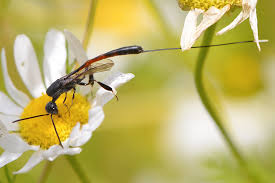 (Beyond Pesticides, December 1, 2017) Ichneumonid wasps (family Ichneumonidae), are a widely distributed parasitoid wasp family within the order Hymenoptera. The name âichneumonidâ comes from Greek words meaning âtrackerâ and âfootprint.â And females do indeed hunt for suitable âhostsâ by first identifying the organismâs food source. Once a suitable host is found, females deposit eggs onto the unsuspecting insect larvae where, within ten days to several weeks, the Ichneumonid larva kills the host by feeding on its body fluids before it emerges. They are also known as âscorpion waspsâ for the extreme length and curving motion of their segmented abdomens. Note: both adult males and females are stingless, and feed on nectar.
(Beyond Pesticides, December 1, 2017)Â Ichneumonid wasps (family Ichneumonidae), are a widely distributed parasitoid wasp family within the order Hymenoptera. The name âichneumonidâ comes from Greek words meaning âtrackerâ and âfootprint.â And females do indeed hunt for suitable âhostsâ by first identifying the organismâs food source. Once a suitable host is found, females deposit eggs onto the unsuspecting insect larvae where, within ten days to several weeks, the Ichneumonid larva kills the host by feeding on its body fluids before it emerges. They are also known as âscorpion waspsâ for the extreme length and curving motion of their segmented abdomens. Note: both adult males and females are stingless, and feed on nectar.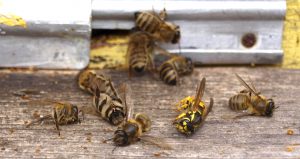 both contain the active ingredient, sulfoxaflor, which is highly toxic to bees. The ruling overturned the decision by Franceâs health and environment agency, ANSES, to allow the use of the sulfoxaflor products. Sulfoxaflor use was also challenged in the U.S. by beekeepers concerned about its impact on already declining bee populations.
both contain the active ingredient, sulfoxaflor, which is highly toxic to bees. The ruling overturned the decision by Franceâs health and environment agency, ANSES, to allow the use of the sulfoxaflor products. Sulfoxaflor use was also challenged in the U.S. by beekeepers concerned about its impact on already declining bee populations. industry-fueled attacks on its reputation in the wake of
industry-fueled attacks on its reputation in the wake of 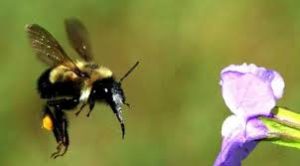 (Beyond Pesticides, November 28, 2017) Bumblebees exposed to field-realistic levels of neonicotinoid insecticides have problems with âbuzz pollinationâ that results in reduced pollen collection, according to new research published in
(Beyond Pesticides, November 28, 2017) Bumblebees exposed to field-realistic levels of neonicotinoid insecticides have problems with âbuzz pollinationâ that results in reduced pollen collection, according to new research published in  (Beyond Pesticides, November 27, 2017)Â Congress is working on the 2018 Farm Bill, which will determine how $956 billion of our tax money will be spent over the coming years in shaping our food system. This year, U.S. Representative Earl Blumenauer (D-OR) has introduced a
(Beyond Pesticides, November 27, 2017)Â Congress is working on the 2018 Farm Bill, which will determine how $956 billion of our tax money will be spent over the coming years in shaping our food system. This year, U.S. Representative Earl Blumenauer (D-OR) has introduced a  (Beyond Pesticides, November 22-23, 2017) As we sit with friends and family this Thanksgiving, let us appreciate how our delicious meal got to your table. The turkey, potatoes, stuffing, and cider all originated in fields far from our homes, and those working in those fields deserve our thanks. They deserve our thanks because many of these workers work long hours, under deplorable conditions, and are exposed to pesticides that put their health and that of their families at risk. So, as we enjoy our pumpkin pie, cranberry sauce, and apple crumble, remember all the hardworking farmworkers who have helped to bring our meal to the Thanksgiving table. At the same time, we give thanks for the environment that is so plentiful and nurturing of life, and remember the importance of pollinators and biodiversity in sustaining life.
(Beyond Pesticides, November 22-23, 2017) As we sit with friends and family this Thanksgiving, let us appreciate how our delicious meal got to your table. The turkey, potatoes, stuffing, and cider all originated in fields far from our homes, and those working in those fields deserve our thanks. They deserve our thanks because many of these workers work long hours, under deplorable conditions, and are exposed to pesticides that put their health and that of their families at risk. So, as we enjoy our pumpkin pie, cranberry sauce, and apple crumble, remember all the hardworking farmworkers who have helped to bring our meal to the Thanksgiving table. At the same time, we give thanks for the environment that is so plentiful and nurturing of life, and remember the importance of pollinators and biodiversity in sustaining life.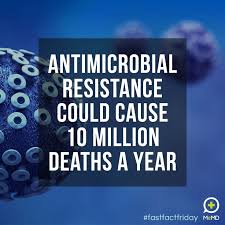 according to the latest research from New Zealand scientists,
according to the latest research from New Zealand scientists, 
 findings on the risk of three highly toxic organophosphate pesticides to endangered species. The move is widely seen by environmental advocates as influenced by the chemical industry, in particular the
findings on the risk of three highly toxic organophosphate pesticides to endangered species. The move is widely seen by environmental advocates as influenced by the chemical industry, in particular the 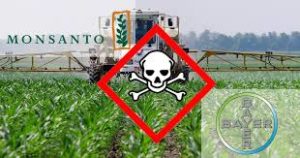 proposed merger of Bayer (BAYN) and Monsanto (MON). The signatures were delivered as two new reports reveal devastating impacts that will be caused by the merger on consumers and farmers, including higher food prices, less innovation, limited seed choices, and escalating dependency of toxic chemical inputs in food production.
proposed merger of Bayer (BAYN) and Monsanto (MON). The signatures were delivered as two new reports reveal devastating impacts that will be caused by the merger on consumers and farmers, including higher food prices, less innovation, limited seed choices, and escalating dependency of toxic chemical inputs in food production. Reports. With the organophosphate
Reports. With the organophosphate  Member states voted last week, but failed to approve, continued use even after months of deliberation over the controversial herbicide. Glyphosate (Roundup) is also up for review in the U.S., but many expect the herbicide to be reregistered by the U.S. Environmental Protection Agency (EPA), despite health concerns.
Member states voted last week, but failed to approve, continued use even after months of deliberation over the controversial herbicide. Glyphosate (Roundup) is also up for review in the U.S., but many expect the herbicide to be reregistered by the U.S. Environmental Protection Agency (EPA), despite health concerns.
 damage, the Arkansas State Plant Board (ASPB) voted earlier this week to prohibit the use of the weedkiller in agriculture during the next growing season. If officially approved by a subcommittee of the state legislature, the new regulations will make dicamba applications between April 16 and October 31, 2018, illegal for Arkansas farmers. The move by the State Plant Board is a huge blow to multinational agrichemical companies Monsanto and BASF, both of which have developed genetically engineered (GE) soybean crops tolerant of dicamba herbicides.
damage, the Arkansas State Plant Board (ASPB) voted earlier this week to prohibit the use of the weedkiller in agriculture during the next growing season. If officially approved by a subcommittee of the state legislature, the new regulations will make dicamba applications between April 16 and October 31, 2018, illegal for Arkansas farmers. The move by the State Plant Board is a huge blow to multinational agrichemical companies Monsanto and BASF, both of which have developed genetically engineered (GE) soybean crops tolerant of dicamba herbicides. Affairs (VA) Secretary David Shulkin announced last week he intends to delay a decision to expand coverage to new illnesses. Despite a
Affairs (VA) Secretary David Shulkin announced last week he intends to delay a decision to expand coverage to new illnesses. Despite a 
